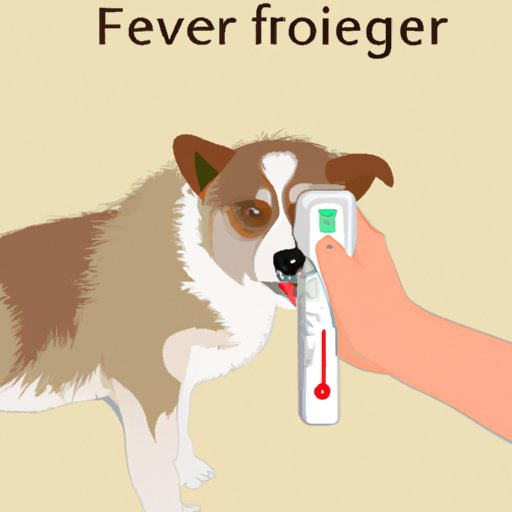
Introduction
Dogs are more than just pets; they’re members of our families. And just like any other family member, we want to make sure they are healthy and happy. One way to keep them healthy is by regularly monitoring their body temperature. Fever is a common sign of illness in dogs, and it’s important to know the signs and symptoms so you can take action quickly. In this article, we’ll explore how to tell if your dog has a fever, what to look out for, and how to take their temperature at home.
6 Telltale Signs Your Dog May Have a Fever
The following are six of the most common signs your dog may have a fever:
- Lethargy: If your dog is lethargic or seems weak, it could be a sign of a fever. A fever can cause your dog to feel tired and not want to move around much.
- Loss of Appetite: A fever can cause your dog to lose their appetite or not want to eat as much as usual. If your dog is skipping meals or not showing interest in food, it could be a sign of a fever.
- Coughing/Sneezing: If you notice your dog coughing or sneezing more than usual, it could be a sign of a fever. A fever can cause respiratory symptoms in dogs, just like in humans.
- Nasal and Eye Discharge: If your dog has discharge from their eyes or nose, it could be a sign of a fever. A fever can cause a runny nose or eyes, or even cause them to become red and swollen.
- Vomiting/Diarrhea: While vomiting and diarrhea can be caused by a number of things, it is a common sign of a fever in dogs. If your dog is vomiting or having diarrhea along with other symptoms, it could be a sign of a fever.
- Panting: If your dog is panting more than usual and doesn’t seem to be cooling down, they may have a fever. Panting is a common symptom of fever in dogs, and it’s important to monitor their temperature if you notice this behavior.
A Guide to Understanding Your Dog’s Body Temperature
The average body temperature for dogs is between 99.5°F and 102.5°F (37.5°C and 39.2°C). However, this can vary depending on factors such as age, activity level, and even the time of day. The best way to determine your dog’s baseline temperature is to take their temperature when they are healthy.
To take their temperature, you will need a thermometer specifically designed for dogs, and a water-based lubricant such as petroleum jelly. Insert the thermometer into your dog’s rectum and wait for the beep. You can also feel your dog’s ears or paws. If they feel warmer than usual, it could be a sign of a fever.
Is Your Dog Acting Strange? It Could Be a Fever
In addition to the six signs listed above, your dog may exhibit other symptoms if they have a fever. These can include:
- Shivering: A fever can cause your dog to tremble or shiver, even if they are not cold. This is a sign that their body is attempting to regulate their temperature.
- Dehydration: If your dog has a fever, they may become dehydrated. Signs of dehydration in dogs include dry gums, sunken eyes, and panting.
- Lack of interest in Activities: If your dog has a fever, they may be less interested in daily activities and not want to play as much as usual.
If you notice any of these symptoms, it’s important to monitor your dog’s temperature and contact your veterinarian for advice on what to do next.
The Importance of Recognizing Symptoms of a Fever in Your Dog
Recognizing the symptoms of a fever in your dog is crucial. If left untreated, a fever can lead to serious health problems, including dehydration and organ damage. Early recognition and treatment can help prevent these complications and ensure a speedy recovery for your dog. As a dog owner, it’s important to monitor your dog’s health and communicate with your veterinarian about any concerns you have.
How to Take Your Dog’s Temperature and Spot Signs of a Fever
Here are the steps to take your dog’s temperature at home:
- Ensure that your dog is calm and relaxed
- Apply a water-based lubricant to the thermometer
- Insert the thermometer into your dog’s rectum and wait for the beep
- Read the thermometer and record the temperature
It’s important to be gentle when taking your dog’s temperature to prevent injury. If your dog becomes agitated or moves too much, it may not be safe to take their temperature at home. In this case, it’s best to contact your veterinarian for assistance.
You can also spot signs of a fever by feeling your dog’s ears and paws. If they feel warmer than usual, it could be a sign of a fever. If you notice any symptoms of a fever, it’s important to contact your veterinarian for advice on what to do next.
Conclusion
Knowing the signs and symptoms of a fever in your dog is an important part of being a responsible dog owner. By monitoring your dog’s health regularly and recognizing the signs of a fever, you can help them stay healthy and happy. Remember to take your dog’s temperature at home and seek professional advice if you notice any signs of illness. With these tips, you can be confident in knowing that your furry friend is in good hands.





